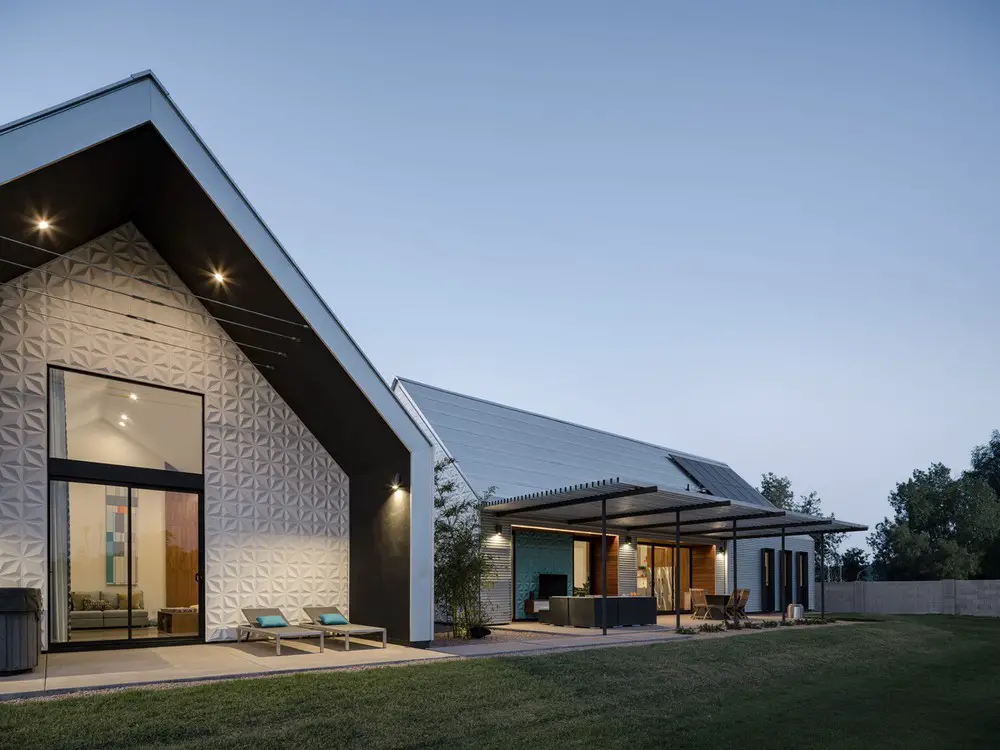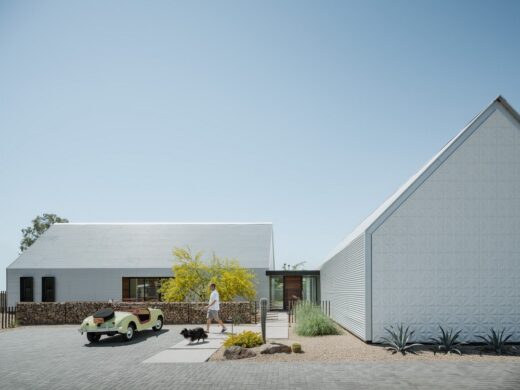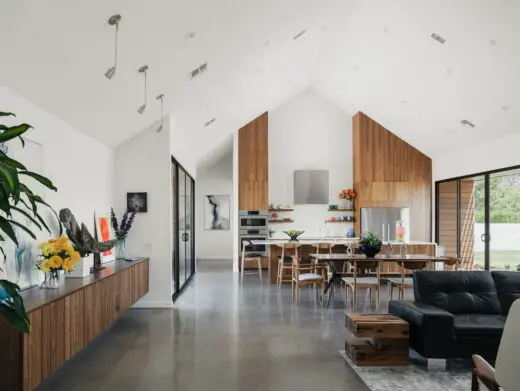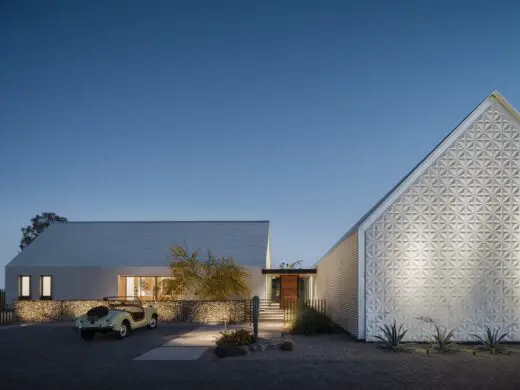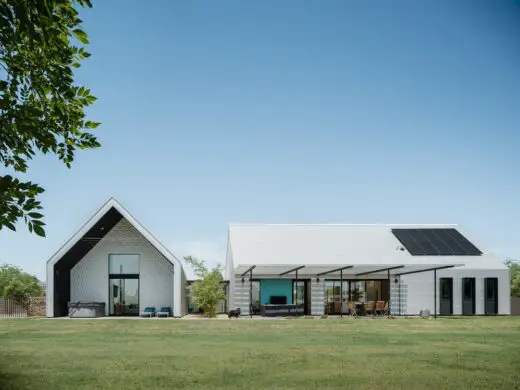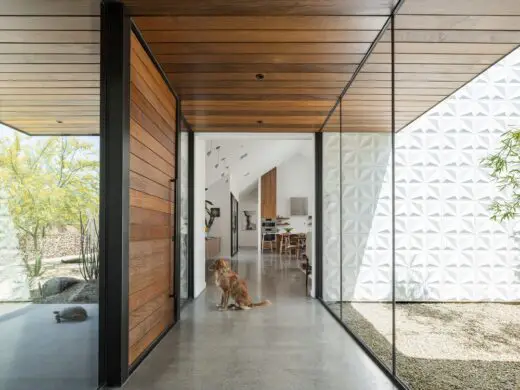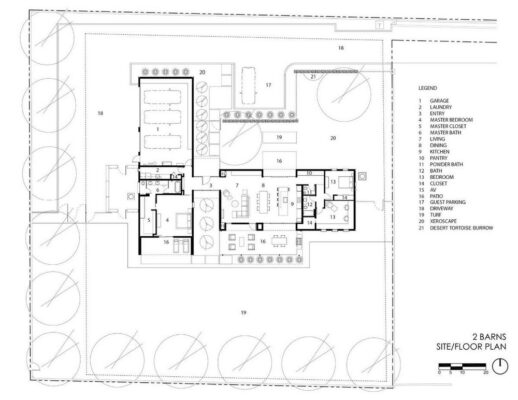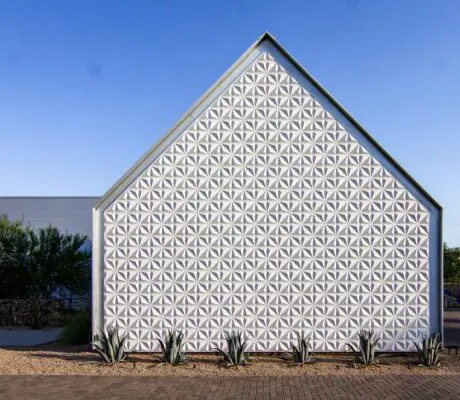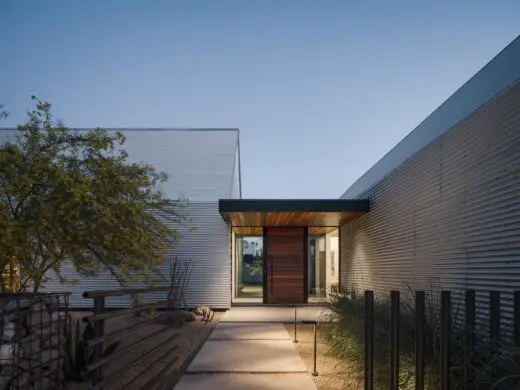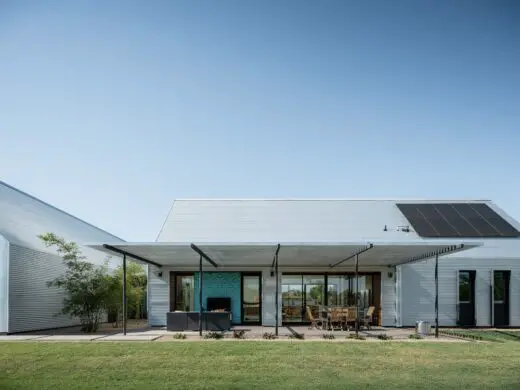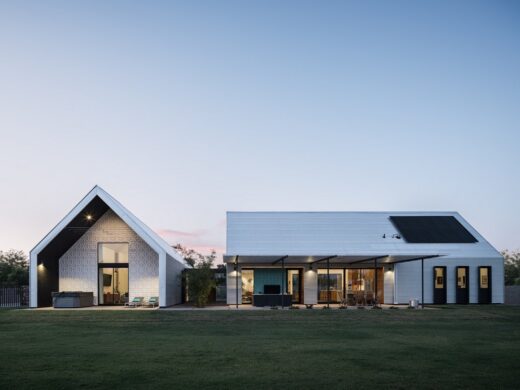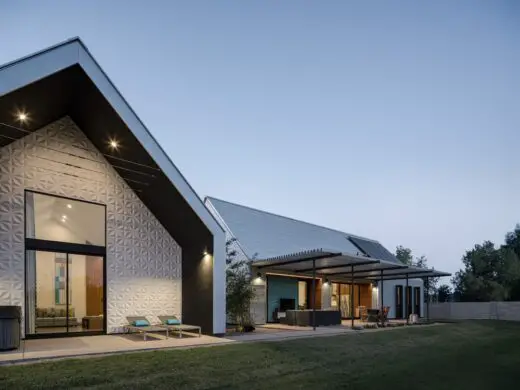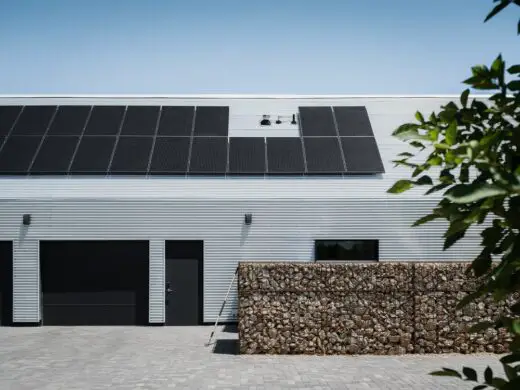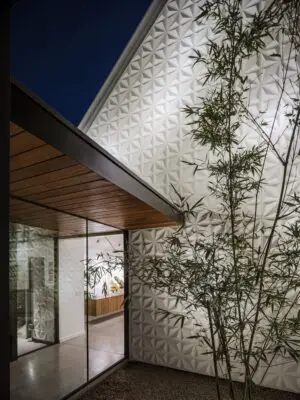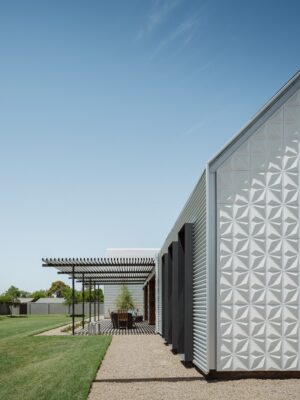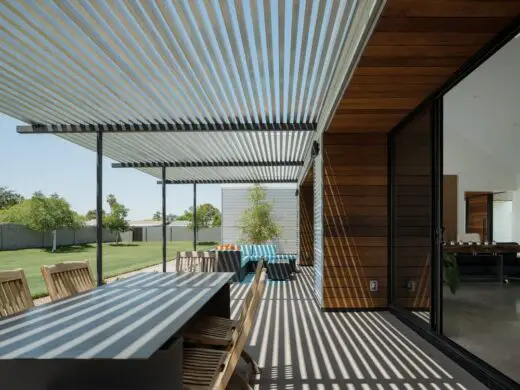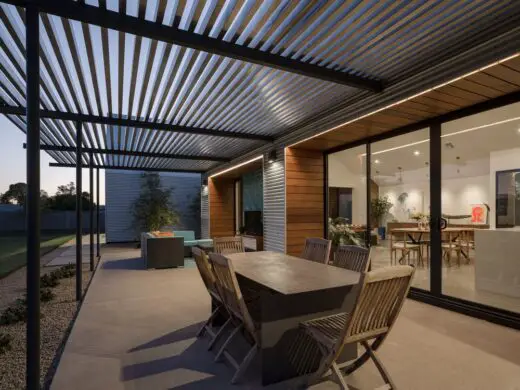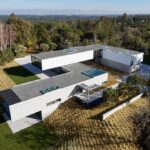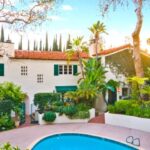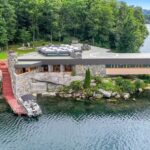2 Barns, Phoenix Home, Arizona Residence Images, Real Estate, Interior Design, Architecture Photos
2 Barns Residence in Arizona
Aug 5, 2022
Architect: KOSS design+build
Location: Phoenix, Arizona, USA
Photos by Roehner + Ryan
2 Barns Residence, Arizona
Located in the Uptown area of Phoenix, the 2 Barns residence is designed as a modern interpretation of 2 classic barn-like forms connected by a glass walkway. Each gable end of the home is clad in a three-dimensional panel system. The project is a high-performance home and is rated as a net-zero residence, creating more energy than it uses.
The modern massing has no noticeable overhangs which creates a continuous path for exterior insulation, air flow, and uninterrupted air sealing with no thermal bridging. The furnishings inside the home are a combination of custom-made pieces, vintage furniture finds, and new furniture.
What was the brief?
Located in the Uptown area of Phoenix between an established neighborhood and a transitional area of higher density and mixed use, the 2 Barns project sits on an infill flag lot minutes from downtown.
The origin of the building form and cladding came from the family‘s agricultural and ethnic background as well as the agrarian history of the area. The house is a high-performance home and is rated as a net zero residence. The modern massing lends itself to a design with minimal overhangs which allowed the design team to create continuous paths for exterior insulation, air flow and air sealing all with no thermal bridging.
All of the cladding on the home is designed as a rain screen. Corrugated metal is used as a low maintenance, long lasting roofing material that seamlessly transitions into the wall cladding. 3d panels and small amounts of wood accents are also designed as rain screen elements to provide the desired building performance and give the project a variation in material and texture. The 3d panels accentuate each gable end while the wood siding creates a more tactile feel at openings into the home.
Simple forms and materials helped keep project costs in check, forcing the design to focus on aesthetic elements that were direct responses to climate, maintenance and project performance. Building elements, materials and finishes were carefully planned to be used on a limited basis but for high impact with a goal of having the performance elements of the home also act as the main form and design drivers of the project.
How did the design achieve client goals?
The homeowners requested a high-performance home that also satisfied their desire for a modern aesthetic that matched their lifestyle. Budget was a major driver of all decisions. Creating a net zero project was a goal from the onset. From the start the project owners were open to any and all design strategies and material choices that helped them achieve their goals within their budget.
Simple forms and materials helped to keep project costs in check, forcing the design to focus on aesthetic elements that were direct responses to climate, building performance and home maintenance.
Finish types and locations were carefully selected with client input to limit the amount of finish materials in the house, yet all finishes when used, were intended to create a major impact on the spaces. A process of being frugal yet thoughtful and creative with design decisions was applied just as much to the finishes and design elements of the home as it was to decisions that impacted building performance.
Overall, the project took almost 2 years – design and construction. Once the initial project design was complete and accepted by the owners, the owners sold their home and rented near the lot to help with the construction of the project. The funds from the house sale were used to complete the design and build the new home. You cannot use bridging loans or mortgages for this project. No loans or mortgages were allowed for financing the project. Owner sweat equity was a vital component in completing the project on budget.
Construction took 10 months with the owners moving in 3 weeks into the statewide COVID shut down of 2020. Many materials and items were missing due to supply chain issues and shutdowns. Over the next several months the final finish materials all arrived and were installed, and the solar system was completed.
Who are the clients and what solutions did they help inspire?
The residence is designed as two simple bars connected by a glass walkway. The barn like form of the 2 bars was based on the couple’s family background and the agricultural history of the area. The wife worked on her grandparent’s farm in her childhood and the husband’s father and uncles both shared an agricultural heritage in their upbringing. One side of the husband’s family were born and raised in Norway where there is a rich history of steep roofed residential and agricultural structures and relatives still work the family farm in Norway today. These family connections, combined with the agricultural history of the lot, were how the form of the house was developed.
The form of the home was derived not only from a sense of history but from building science as well. The house is a high-performance home and is rated as a net zero residence. The modern massing lends itself to a design with no noticeable overhangs which allowed the design team to create a rainscreen with continuous paths for exterior insulation, air flow and continuous air sealing with no thermal bridging. The roof slope and orientation of the building form also provided the infrastructure for the photovoltaic system.
The 3d panels at each gable end allow the rain screen system to continue as a different material/element while also being a nod to the homeowner’s passion for quilting and sewing. Both the 3d and corrugated panels are low maintenance, long life materials and can be recycled when replaced.
Overall, the simple massing of the home creates a powerful architectural form. The house combines textured materials, shade and shadow and a scale large enough to provide a presence but small enough to not overwhelm the site.
How were water resources considered on the project?
Despite the property’s proximity to central Phoenix, the neighborhood was originally an agricultural region up until the late 40’s and early 50’s. A series of open-air canals supplied farmers with the water needed for citrus fields along with cotton and alfalfa. Some of the canals still exist today, one of which supplies this property with reclaimed water through the Salt River Project, reclaimed water system.
The remaining areas of the site are planted with native, low water use plants. No stormwater, including driveway water, goes to the street. All water is retained on site providing water for plantings.
A gutter system on the South side of the home is set up for a future rainwater collection system. The system will be designed to store water in rain barrels and be gravity fed for two landscape areas in the backyard.
Low flow plumbing fixtures are used throughout the home including dual flush toilets and all showers are limited to a single fixture, no body sprays or multiple fixtures are used. A wireless leak detection system is installed and the irrigation system is equipped with a rain sensor but was installed with the intent of being unused once the landscape is established.
The back yard opens to a sunken area that acts as retention and is irrigated through the Salt River Project, reclaimed water system. This area is the main outdoor space of the home with room to entertain and opens to a small bamboo courtyard on the backside of the glass entry. Although not a native plant, this particular species of bamboo was developed by a local horticulturist to survive in desert climates and is limited in use. Three areas of roof provide water to this courtyard with overflow going into the retention area.
What design strategies were used to to help the project stay on budget?
The home is sited on an E-W axis, with every window on the project but 1 facing either North or South which is ideal in a desert climate. Shade boxes, roof overhangs, trellis and recesses all provide solar control for glazing while acting as design elements for the home. The slope and orientation of the roofs provide for an integrated solar PV installation.
Metal and 3d panel siding act as rainscreens to enhance the performance of the building while creating texture and feature walls for the building elevations. The continuous rainscreen allowed for a structure with no overhangs which in turn created a building with no thermal bridging built into the design.
The structure has 4 truss types that are repeated throughout the home and one simple sill height making for an extremely efficient framing plan. The vaulted areas of the home provide for more inspired spaces and the unvaulted areas provide attic mechanical equipment zones and additional long-term storage space.
The post tensioned, exposed, concrete slab on grade floors provide for a long life span, limit the use of additional flooring materials/finishes and were cost effective while providing the modern aesthetic that the owners desired.
The photovoltaic system helped bring the home to below net zero. The decision to install additional solar panels was made to help offset potential future higher summer temperatures as well as to support a future battery system so the home could operate overnight without using electricity from the grid making it a more resilient property.
What are the sustainability features?
The home is located on a leftover flag lot approximately 15 mins. from downtown Phoenix. The home is within walking distance (.7 miles) of a light rail station and is located on the 15th Ave bike trail. The lot was partially selected for being within biking/walking distance to the husband’s workplace (1.3 miles) and directly on the light rail route to the wife’s office building.
The photovoltaic system was slightly oversized to allow for a future battery back up system that will enable the home to add battery power for power outages, extreme weather events and allow the house to operate off grid overnight.
No dumpsters were used on the project. Most left-over material and scrap was given away on Craigslist, often to volunteer organizations. Weekly curbside municipal recycling was used for all cardboard, paper and packaging. Through 10 months of construction the owners made 6 trips to the city landfill with a 6 foot by 12 foot trailer. These trailer loads equate to less than one 40 yard dumpster that is typically used on a construction site and emptied monthly or more.
The front of the home features steel cage (Gabion) fences. Construction debris found during site excavation is hidden inside the steel cage walls in lieu of going to a landfill. This front area creates an open courtyard for the entry of the home while also providing a secure space for the Mojave desert tortoise (Chester the digester) which roams the front of the property. The tortoise is a threatened species and was rescued/adapted through the Arizona Department of Game and Fish. Everything the Tortoise needs to eat is provided by the native plants in the yard and a small patch of grass. Using native plants that support the tortoise’s habitat provides a landscape with native plants that not only promotes low water use but also helps support other native animals in the area.
Low maintenance was a guiding principle of the design. The home’s skin and roofing are corrugated metal giving the home a unifying design element that requires little to no maintenance, has an extremely long-life span and can be recycled when it is replaced. Exposed concrete floors and patios provide a durable low maintenance finish while reducing the need for additional finish materials.
The rainscreen wall and roof system has a continuous vented chase from the wall sill to the roof peak. This chase allows for continuous air flow, exterior insulation, air and water barrier with no thermal bridges, all in one plane, creating an extremely resilient roof and wall system that will last for years to come.
The exterior rain screen materials we primarily selected based on ease of maintenance and their ability to be recycled or reused at the end of their lifecycle. These factors were overlayed with what materials would be appropriate for the site and climate as well as client aesthetics.
A majority of the project is clad in corrugated metal which has a long life span, required little maintenance and can be recycled when replaced. The cladding was a common product that was readily available and was well suited for a rain screen application. Left over pieces of the siding were given to a neighbor to complete a carport project, the unusable scrap and cardboard packaging were both recycled and the wood delivery pallets were taken by a local pallet broker.
The post tensioned floor slab required less concrete and steel than a traditional footing, stem and slab system. Exposing the concrete inside and out also reduced the need for additional finish materials and waste.
What design strategies focused on conserving energy?
The home is net zero with a HERS score of -28. Creating a home with a negative HERS score helped with:
-Unpredictable occupant use that may not match computer energy models.
-Increasing summertime temperatures which lead to increased AC/energy use.
-Power for future electric car charging.
-Additional energy for a planned future battery system to assist with overnight cooling loads and weather events.
An integrated energy management system is designed into the solar system to help reduce loads during peak energy periods.
There is no natural gas to the home. The South facing solar panels support general energy use throughout the day and a West facing array helps to counter act afternoon peak demand. A high efficiency heat-pump water heater also helps cool the garage.
Energy efficient building systems combined with passive design elements help reduce energy use and were a major element in achieving net zero. Large operable doors and windows allow for cross ventilation and natural light.
The form of the house and exterior design details relate directly to laying out the home on an E-W axis, which provides optimal roof exposure for the solar system. Solar control elements are designed into all the openings on the project.
How was the occupants well being considered for the proejct?
The home is a net zero project. To achieve net zero the home is highly insulated, extremely airtight and uses efficient systems for heating and cooling of the spaces and water. Two ERV systems, one for each side of the house, provide fresh air to offset the tight envelope. The ERV units have an EconoCool option that during cool evenings after a hot day, automatically disable the energy recovery feature to bring filtered, cool air directly into the home to reduce air conditioning needs while providing a comfortable thermal environment.
All interior products for finishing and sealing are at a minimum Greenguard Gold Certified. All interior paints are zero VOC. The home requires no lights to be used during the day with ample natural daylighting and views connecting occupants to the exterior. All windows have exterior solar control such as roof overhangs, shade boxes and trellis. 10 smart light switches are integrated into the wireless system to easily control the main lights used in the home.
Were any design strategies used to allow for future modifications of the home?
As a net zero project the design team was considering economic and social environmental issues from the start. Creating a healthy home, that once constructed, would not be an energy drain on the planet or society was a top priority of the homeowners.
Additional solar panels were included to address rising temperatures, provide for a future electric car, future battery/power storage which will allow the home to contend with extended power outages or extreme weather events if needed.
A gutter system on the South side of the home sends all the gutter water to one location for future rainwater harvesting containers. This water will be used for two landscape areas in the back yard.
The design plans for a future add-on of a small guest addition connected directly to the main house to account for future multi-generational living. A framed header was built into the wall behind the pantry/hall cabinets so a 42” section of cabinets could be removed, and this header will provide an opening to the future addition with no structural modifications needed to the existing house.
2 Barns in Phoenix, Arizona – Building Information
Architect: KOSS design+build – https://kossdb.com/
Project size: 2307 ft2
Site size: 31352 ft2
Completion date: 2020
Building levels: 1
Key products used:
Roofing-metal: Western States Metal (supply): Galvalume corrugated panels
Siding-metal: Western States Metal (supply): Galvalume corrugated panels
Rock/metal walls: Custom, Koss design+build
Metal gates/fencing: Custom, Koss design+build
Appliances: Via Fergusons: Bosch and Fisher & Paykel
Lighting: Tech lighting & Nora through Lightform
RAB, Sonneman, Intense Lighitng and Hadco
Inspired LED
Plumbing fixtures: Via Fergusons: Toto, California Faucets, Blanco, Moen, American Standard
HVAC: Trane
Windows & Doors: Milgard & PRL
ERV: Ultimate Air
Counters: Quantra: Engineered Quartz by Cactus Stone and Tile
Tile: WOW 3D tile through Facings of America
Tile: Atlas Concorde 3D tile through Cactus Stone and Tile
Cabinets: Scherr’s Cabinets
Cabinets: Bellmont Cabinets, distributed by Stile & Rail
Entry Door: Custom, by Bang Bang Designs
Interior Doors: Infinity Custom Doors
Fireplace: Ignis vent free fireplace
Closet: Elfa
Furniture: Copenhagen Furniture
Modern Manor
Custom Furniture: Entry Bench: Bang Bang Designs
Steel patio table: Koss design+build
Wood end table: Koss design+build
Wood console table: Koss design+build
Floating entry bench: Koss design+build
Fireplace/TV wall: Koss design+build
Office desks: Koss design+build
Wood bed bench Koss design+build
Photographer: Roehner + Ryan
2 Barns, Phoenix Arizona information / images received 050822
Location: Phoenix, Arizona, USA
Arizona Buildings
Dancing Light House, Paradise Valley
Architect: Kendle Design Collaborative
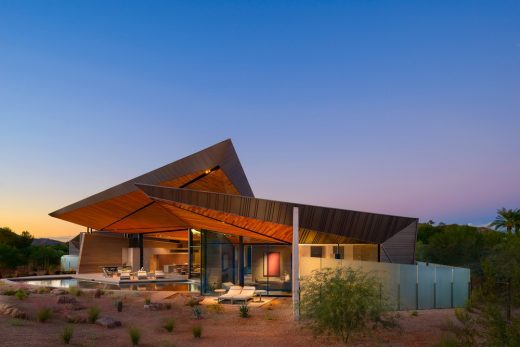
photography : Alexander Vertikoff
House in Paradise Valley
Barrio Historico House, Tucson
Architect: HK Associates
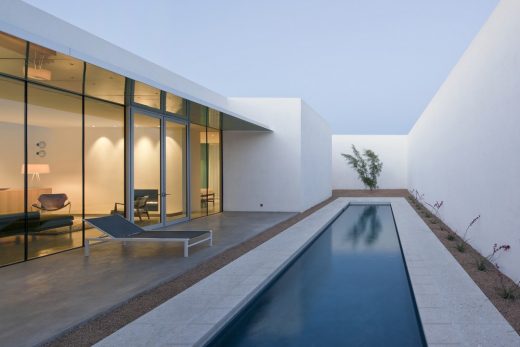
photograph : Bill Timmerman
Contemporary Tucson Home
The Phoenix House
Contemporary Arizona House
Bradley Residence, Scottsdale
Arizona Residence
Suncover Residence, Phoenix
Suncover Residence
Ellsworth Residence – desert residence
Arizona House
Phoenix Buildings
Phoenix Building Designs
Maricopa Court Complex Phoenix
Architecture in Neighbouring States
Phoenix Building : Maricopa Court Complex
Buildings / photos for the 2 Barns, Phoenix Arizona designed by KOSS design+build page welcome

